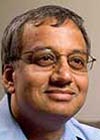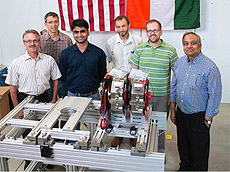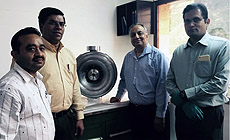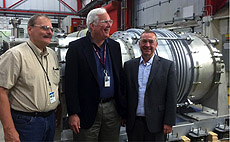Progress on the Indian Institutions and Fermilab Collaboration
 |
|
Shekhar Mishra
|
Shekhar Mishra, deputy project manager of PIP-II, wrote this column.
Fermilab's proposed construction of PIP-II (Proton Improvement Plan II) as part of the laboratory's long-term strategy is to transform its accelerator complex to support 1.2 megawatts of beam power for the world-leading Deep Underground Neutrino Experiment (DUNE).
PIP-II R&D is being jointly carried out by the Indian Institutions and Fermilab Collaboration, which includes the Inter-University Accelerator Center (IUAC) and three Indian Department of Atomic Energy (DAE) laboratories: the Raja Ramanna Centre for Advanced Technology (RRCAT), Bhabha Atomic Research Center (BARC) and Variable Energy Cyclotron Center (VECC). Both RRCAT and BARC have proposed construction of two accelerators that will rely heavily on advances in Fermilab's program in superconducting radio-frequency technology, known as SRF.
The Indian Institutions and Fermilab Collaboration (IIFC), established in 2009 for the joint development of superconducting radio-frequency proton accelerator technology, has made significant progress. Hardware developed by our Indian partners under IIFC is starting to arrive at Fermilab for integration into R&D programs. Here are some recent highlights:
1. As a part of the PIP-II R&D program, Fermilab is constructing the PIP-II Injector Experiment, or PXIE. BARC is responsible for the design, construction and testing of all PXIE normal-conducting (room temperature) magnets. In April, Fermilab received two prototype magnets from BARC for testing. After recertification of the magnetic measurement by Fermilab, which were also measured at BARC, the magnets are now installed in the PXIE beamline.
 |
This medium-energy beam transport magnet is now installed in PXIE beamline. From left: Mike Tartaglia (Fermilab), Joe DeMarco (Fermilab), Vikas Teotia (BARC), Alexander Shemyakin (Fermilab), Curtis Baffes (Fermilab), Shekhar Mishra (Fermilab). Photo: Reidar Hahn |
2. In May Fermilab received two 325-MHz single-spoke resonator (SSR1) cavities from IUAC. The construction and tests (with beam) of a prototype SSR1 cryomodule incorporating eight cavities is an important goal of the PXIE program. IIFC plans to incorporate these two cavities into this prototype cryomodule. One cavity has been processed and tested by Fermilab. The performance of this cavity is similar to those produced by U.S. industry.
 |
This single-spoke resonator cavity was fabricated at IUAC. From left: Kishore Kumar Mistri (IUAC), P.N. Prakash (IUAC), Shekhar Mishra and Abhishek Rai (IUAC). Photo: IUAC Media |
3. In July, Fermilab received one cryogenic feedcap and one endcap from BARC. These will be used to test the 1.3-GHz cryomodule that Fermilab is currently fabricating for LCLS-II, a future light source based at SLAC. The design was jointly developed by BARC and Fermilab, with Fermilab primarily in a guiding role and BARC assuming responsibility for design, manufacturing and testing. This project required close cooperation between Fermilab and BARC to promote the development of expertise and capabilities crucial to successful implementation of technologies needed for the design and construction cavities and cryomodules for PIP-II.
 |
Fermilab scientist Rich Stanek, DOE Office of High Energy Physics Director Jim Siegrist and Fermilab Director Nigel Lockyer stand by the BARC-fabricated feedcap and endcap. Photo: Shekhar Mishra, AD |
Under the Indian Institution and Fermilab collaboration, RRCAT and VECC have also installed significant SRF cavity design and fabrication infrastructure. A jointly designed and U.S.-fabricated test stand has been made operational at RRCAT. Several prototype cavities have been fabricated, processed and tested.
4. Both BARC and RRCAT have developed 325- and 650-MHz solid-state RF amplifiers for application to PIP-II. These units have been tested. Under IIFC, BARC has developed a new design of the RF protection system. It has also initiated the design of a new low-level RF system. These systems, along with 650 MHz solid-state RF amplifiers, will be commissioned with test stands.
All these efforts will continue to grow over the next several years as PIP-II completes the R&D required to support construction.
Strengthening the collaboration, Fermilab will welcome the arrival of seven Indian scientists and engineers to Fermilab this fall. They will be directly embedded in our Fermilab teams for two years, working on the critical technology development that will allow Fermilab and India to construct PIP-II starting later in this decade.
|